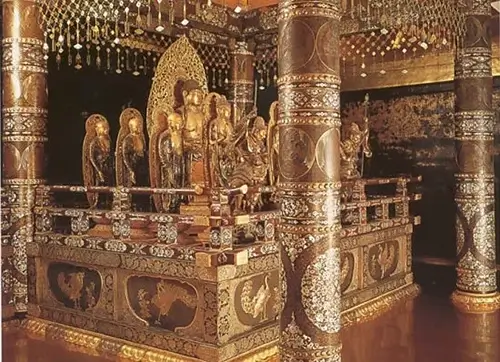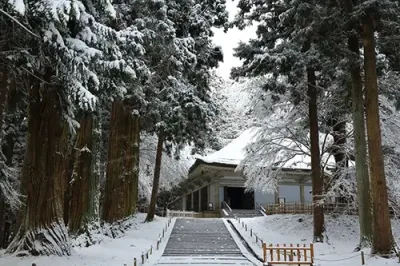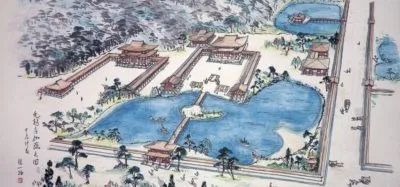Hiraizumi in Iwate Prefecture is a town extending up the Hiraizumi Hill on the west bank of the Kitakami-gawa river. The town prospered for almost 100 years in the 11th and 12th centuries as the center of the Tohoku region. Over 3,000 national treasures and historical sites still remain, telling of the Fujiwara Clan that reigned over the area in the center of its prosperity. The Chusonji temple and Motsuji temple were important places in the area’s turbulent history.

Hiraizumi flourished for nearly one hundred years, during a peaceful era of prosperity. However, hostility from the court in Kyoto and the beginnings of Minamoto no Yoritomo’s reign in Kamakura eventually dragged Hiraizumi into the violent political disturbances of the late twelfth century.
When the younger brother and former general of Yoritomo fell out with his older brother, he fled to the north to Hiraizumi. But soon after he arrived, his protector fell ill and died. The protector’s heir was unable to handle Yoritomo’s pressure to hand over his wayward brother and forced him into suicide. Yet this was not enough to appease Yoritomo, who attacked and ended the century-long dynasty.
Chusonji Temple

The Chusonji temple is on the top of a hill called Kanzan, which is why it is often called the Kanzan Chūsonji. It was founded in 850 by monk Ennin a monk of the Tendai school. Ennin is also known for recording his own travels and study of Buddhism abroad. His writings are regarded by some as some of the world’s greatest travel stories.
It was in the early twelfth century that the Fujiwara clan began the construction of a large temple complex with halls and pagodas here. There were more than 40 halls and pagodas, and over 300 monks’ quarters.
It was hoped that the Chūsonji temple would calm the spirits of those who had died in the battles that had raged in Tohoku in the latter half of the late eleventh century. He also wanted to make a peaceful area based on the principles of Buddhism.
It was written that all visitors, no matter who they are, would be greeted lovingly by the Buddha and always get their blessings. Chusonji’s profits were to be divided evenly and universally to all who needed them.
The Kamakura period was a turning point for the temple. In 1337, a fire damaged the complex greatly. Nevertheless, more than 3,000 treasures still survived. What is special about Chūsonji’s treasures is that they form a coherent collection of many different arts. These included lacquer work, woodwork, metalwork, dyeing, and calligraphy all of which represent the peak of Heian period Buddhist art in this part of Japan.
Motsuji Temple

The Motsuji temple was founded by Ennin at the same time as the Chusonji temple. Chusonji’s founder’s son had the same great vision as his father, and he had his own great temple built, Motsuji, which was completed by his son. It is said that the complex of Motsuji was bigger than that of the Chusonji.
The Motsuji was unfortunately almost completely lost to the fire and wars, but the most important part is its garden. It is called Jodo-Teien or Buddhist paradise garden. The harmony between the temple structure and the pond is ideal. This philosophy of making a garden is described in the oldest gardening text Sakuteiki published in the 11th century.
Takkokunoiwaya in Hiraizumi

Takkokunoiwaya is a Buddhist temple that enshrines Bishamonten, one of the four guardians of Buddha. It is said that it was first constructed by warrior Sakanoue no Tamuramaro to commemorate his victory against the northern enemies in 801. The most unique feature of this temple is that it is standing surrounded by rocks.
Your Japan Tour
As seasoned Japan experts, we create perfect Japan package tours including destinations like Iwate. Check out our group tours and private tours, or contact us to start planning your unforgettable holiday to this fascinating country. Japan is full of once-in-a-lifetime experiences, culture, history, nature, and delicious food!
Chusonji Access Information
Access: 20 minutes walk from Hiraizumi Station (JR Line) or you can take a bus to Tsukimizaka-iriguchi (月見坂入口) bus station
Entrance : Chusonji: Adults 800 yen / High school students 500 yen / Junior high students 300 yen / Elementary Students 200 yen
Hours: From March to November 3, 8.30 am – 5 pm, From November 4 to February 8.30 am – 4.30 pm